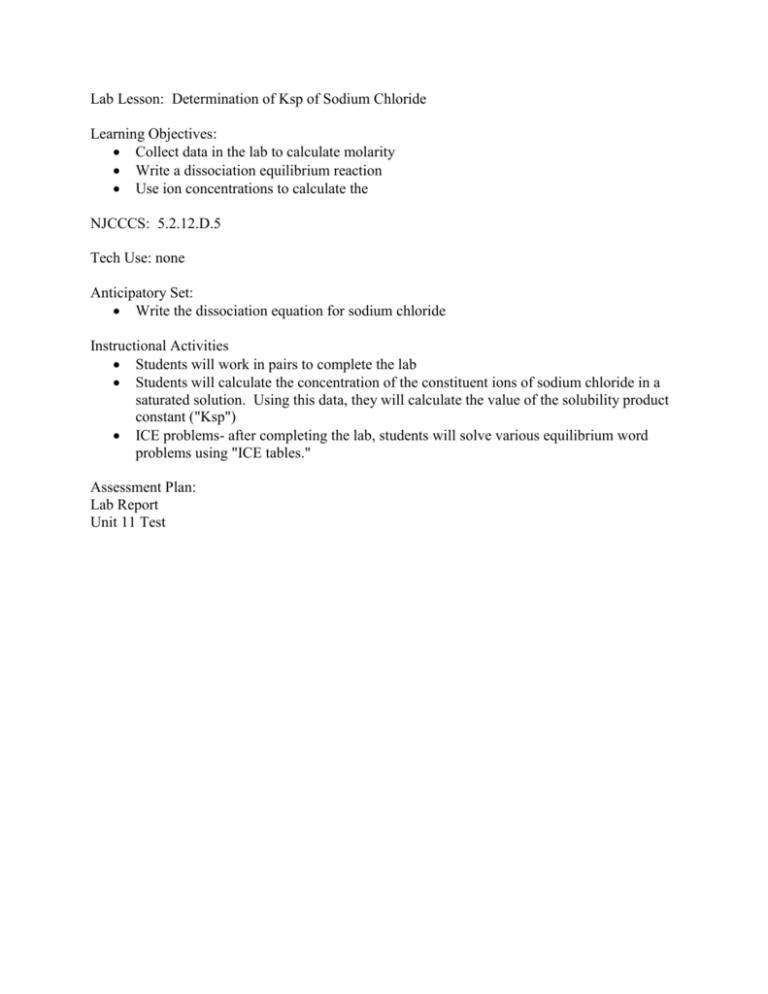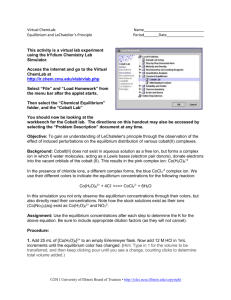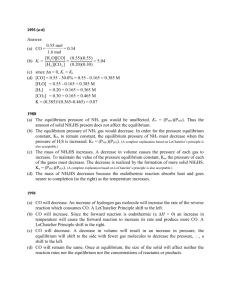Lab Lesson: Determination of Ksp of Sodium Chloride Learning
advertisement

Lab Lesson: Determination of Ksp of Sodium Chloride Learning Objectives: Collect data in the lab to calculate molarity Write a dissociation equilibrium reaction Use ion concentrations to calculate the NJCCCS: 5.2.12.D.5 Tech Use: none Anticipatory Set: Write the dissociation equation for sodium chloride Instructional Activities Students will work in pairs to complete the lab Students will calculate the concentration of the constituent ions of sodium chloride in a saturated solution. Using this data, they will calculate the value of the solubility product constant ("Ksp") ICE problems- after completing the lab, students will solve various equilibrium word problems using "ICE tables." Assessment Plan: Lab Report Unit 11 Test Lesson 1: Equilibrium and LeChatelier's Principle Learning Objectives Relate the magnitude of "K" to the thermodynamically favored direction of reversible reactions Predict which way a reaction at equilibrium will shift when a stress (change in volume, pressure, or concentration) is applied to it NJCCCS: 5.2.12.D.5 Tech Use: LeChatelier Animation Anticipatory Set: Demo using color that demonstrates LeChatelier's Principle Instructional Activities Based on prior knowledge, students will predict how the size of "K" relates to product/reactant concentration LeChatelier's Principle will be defined, and the basic rules introduced. Animation- Based on the animation, students will arrive at the patterns in the way that equilibrium shifts. Guided instruction- several examples will be done on the board as a class Practice in pairs- students will practice applying LeChatelier’s principle in pairs Assessment Plan: Unit 11 Test Lesson 2: LeChatelier's Principle (Continued) and Review Learning Objectives Review the effects of various stresses on equilibrium systems. Review the meaning of the equilibrium constant, and how it can be calculated using ICE tables. NJCCCS: 5.2.12.D.5 Tech Use: none Anticipatory Set: Review Puzzle Instructional Activities: In groups of 2, students will complete a review packet that covers the topics on the test. Brief review game (if time permits) Assessment Plan: Unit 11 Test Lesson 3: (Half Day Chem Olympics) Learning Objectives: Explain the significance of equilibrium principles to the Haber process NJCCCS: 5.2.12.D.5 Tech Use: none Instructional Activities: Students will read a brief article that describes how the Haber process was developed. The article includes several principles of equilibrium and LeChatelier’s principle and is an example of an important industrial application of chemistry. They will answer and submit questions about the article. (from Chang Chemistry textbook) Assessment Plan: Answers will be collected Day 5: Unit 11 Test








